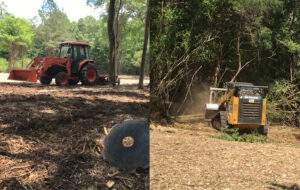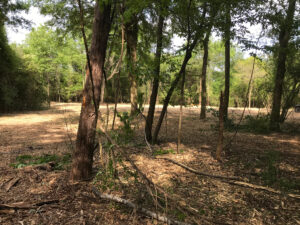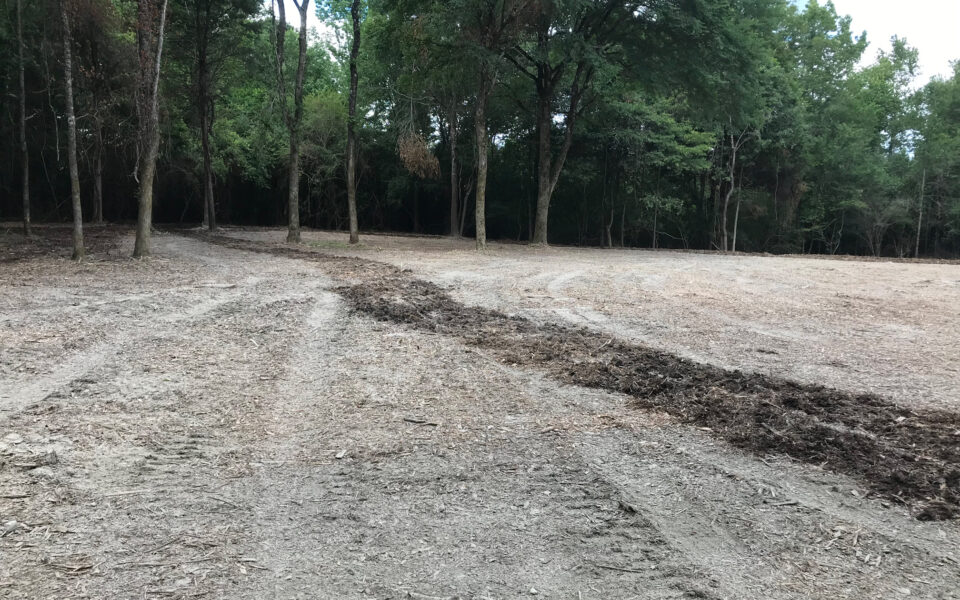There are many newer, modern forms of machinery that can really help on many gamekeepers’ projects. I recently witnessed what a Caterpillar skid-steer mulcher could accomplish in a couple of days. It was nothing short of amazing. This machine helped me reclaim what I assume was an old pasture that had grown up into privet, sweet gum, and elm. It was thick and hairy to say the least, decent bedding for deer and there was a browse line on the privet…but I wanted to create a food plot. The area looked perfect. It was flat ridge top with no valuable timber.
 The mulcher basically worked for three days, 25 hours and created a solid 2 acre opening. A few trees were left in it for potential bow stands and esthetics. The shape matched the contour of the flat area so as to minimize any erosion. The area looked good, hundreds of vines hung around the edges like ropes.
The mulcher basically worked for three days, 25 hours and created a solid 2 acre opening. A few trees were left in it for potential bow stands and esthetics. The shape matched the contour of the flat area so as to minimize any erosion. The area looked good, hundreds of vines hung around the edges like ropes.
The area had been very thick and now there was a layer 4 to 6 inches thick of mulch which was very concerning. I didn’t see any way that the mulch would decay in time to plant this fall (my goal). And with all the stumps and roots left I didn’t see any way to disk the mulch in to incorporate it with the soil. I felt I had two options. Windrow the mulch and burn it and or lightly drag it to the side with a box blade being careful not to drag the topsoil.
I contacted soil expert Johnny McRight, of DeltAg, knowing he would have some solid advice. He didn’t want me to burn the mulch, but seemed to like the idea of raking away as much as I could and then spray the ground with a 32% liquid nitrogen application and 32 ounces of DeltAg Soil Solution.
I learned that decaying wood and leaf matter consumes nitrogen and I needed to add this back. Johnny is an expert at helping farmers deal with cleaning up last year’s crop remnants and knew he could help. My local COOP stocked both products thankfully.
 What I learned is that in order for stumps and roots to decay and turn back into organic matter they need fungus, and fungus needs nitrogen. So by adding the nitrogen back to the soil I am helping the fungus speed up the process and potentially having more nitrogen in the soil than the rotting wood needs. If I wouldn’t have added it, the soil gives precedence to this process (breaking down the organic matter) so it would have robbed the nitrogen and other nutrients from whatever crop was planted.
What I learned is that in order for stumps and roots to decay and turn back into organic matter they need fungus, and fungus needs nitrogen. So by adding the nitrogen back to the soil I am helping the fungus speed up the process and potentially having more nitrogen in the soil than the rotting wood needs. If I wouldn’t have added it, the soil gives precedence to this process (breaking down the organic matter) so it would have robbed the nitrogen and other nutrients from whatever crop was planted.
Along the way, I met Larry Swearingen who lived near the property and had a food plot preparation business. After a solid day of dragging with a box blade, he had worked most of the mulch to the plot edge and pushed it out of the way into depression.
My first soil test from Mossy Oak BioLogic revealed the soil pH to be 5.3 and it needed two tons of lime per acre badly. Larry was able to spread the lime and we hoped to lightly disk the soil to incorporate the lime. That first pass with the disk was a rough one. He broke a glass door in his tractor cab, two disk blades and the axle on his disk. Larry never complained though. I could tell he was a deer hunter and could share my vision for the plot.
This new plot project was getting expensive and was certainly rough on equipment but, it was taking shape. If I could speed up the decaying process, we would be able to break the ground better in September and plant a fall annual like BioLogic Green Patch Plus.








